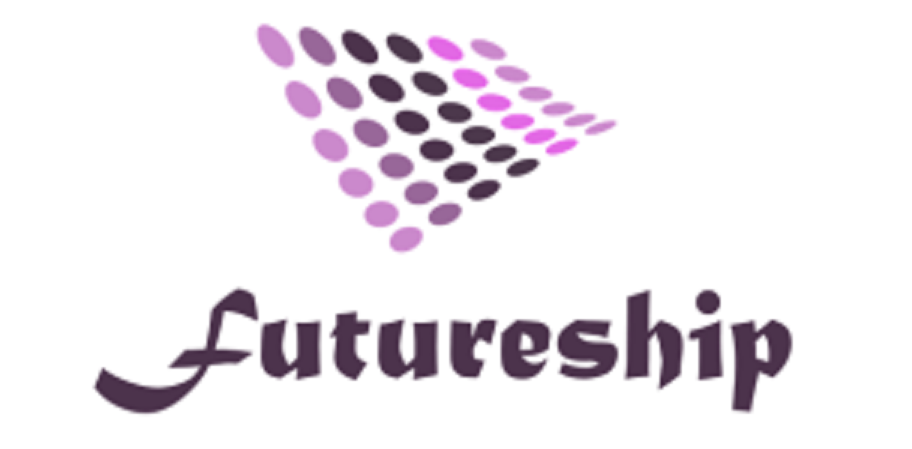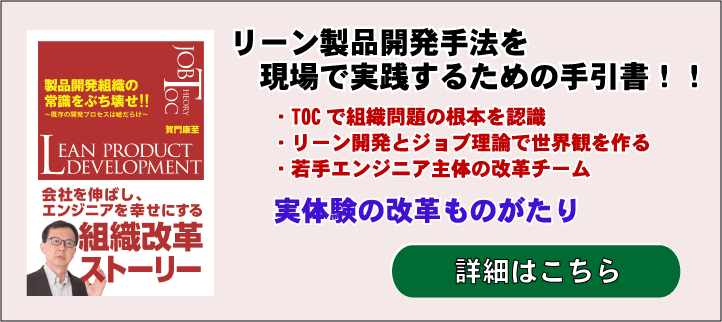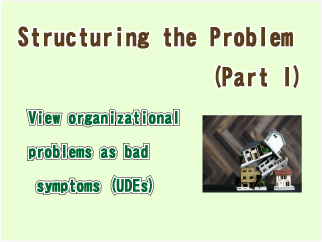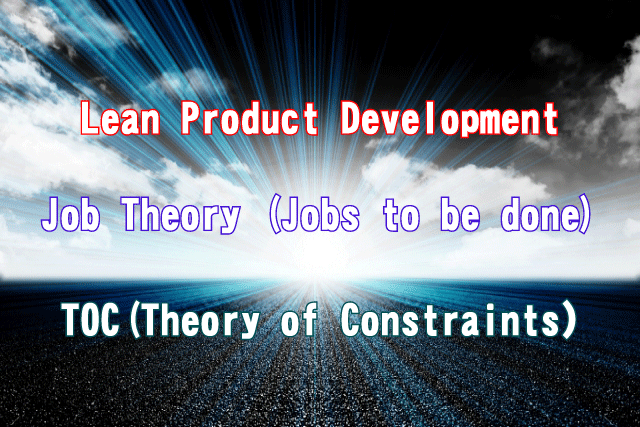
The Toyota method of lean development was originally systematized and theorized based on the research of Toyota researchers in the United States.
Of course, there are many lessons to be learned from the theory, but in order to apply and practice it in the actual product development field, there must be a solid strategy and an action plan based on the strategy.
At Futureship, we not only teach the Lean methodology, but also take responsibility for supporting the development organization from the current situation analysis, goal setting, strategy formulation, planning, and execution.
The basic process of organizational reform that we follow is as follows.
- Diagnosis and analysis of current situation
- Goal (target) setting
- Determination of basic policy
- Action plan
- Implementation support
In the course of these steps, the gap between the theory and what is practiced in the field is taken into account, and an action plan that can be implemented without fail is developed.
Contents of this article
Organizational Change Strategies for Futureship Product Development
In order to reform the product development organization, we use the theory of Toyota’s Lean Development Method as a base, and combine other methods, and finally formulate and implement each reform strategy based on a thorough analysis of each company’s situation.
At that time, the TOC (Theory of Constraints) thinking process is used for diagnosis and analysis of the current situation, and the TOC framework is also used for determining the basic policy of the strategy and formulating the action plan.
The TOC Thinking Process can also be used as a training for logical thinking that eliminates people’s assumptions and perceives things in a simple and accurate way. In our consulting services, we also provide training for engineers using the TOC framework, and we consider the ability to grasp the essence of things obtained through this Thinking Process as the basis for practicing Lean Development Methodology.
Furthermore, in the process of deploying the Lean development methodology, we utilize the job theory to understand customer value and conduct product planning that maximizes customer value.
The figure below shows how to formulate the organizational reform strategy that we recommend.
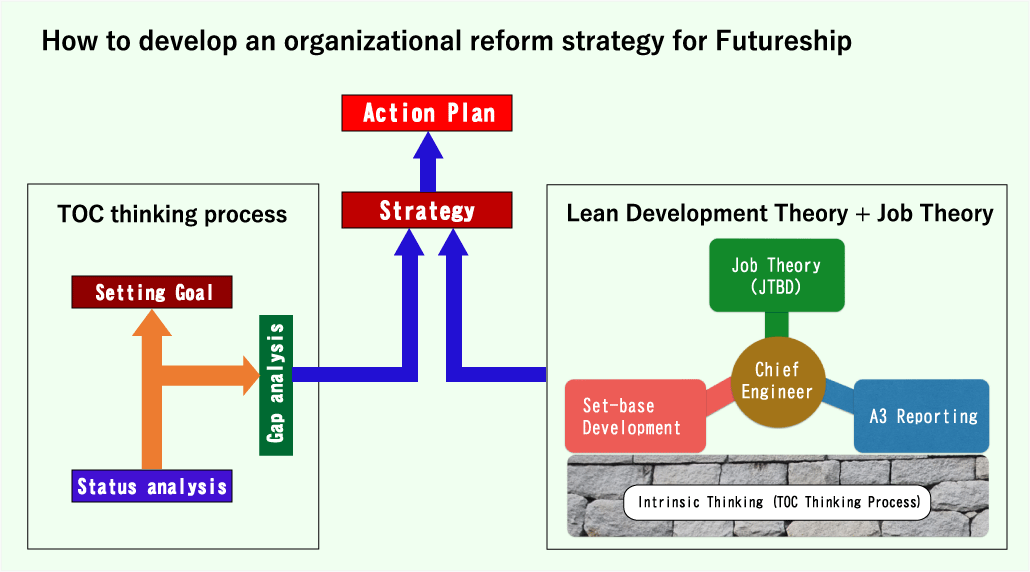
The important point is to understand that Lean Development Methodology is only an understanding of idealism at the stage of learning the methodology. When practicing it in the field, it is necessary to deeply understand the gap between the current status of the organization and its goals, and, to develop a strategy on how to put the idealism into practice.
Steps to bridge the gap between theory and practice
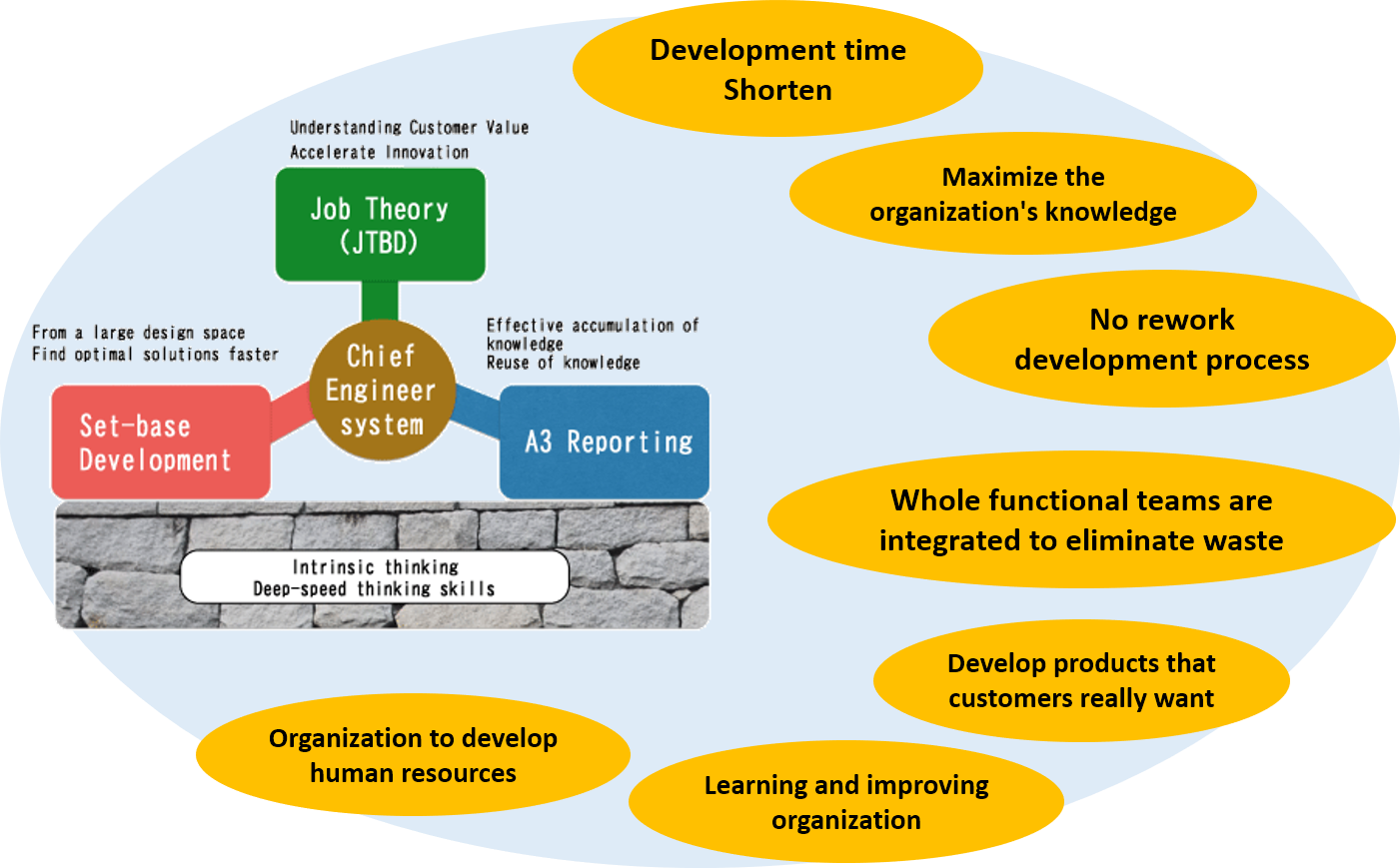
The key components of Toyota-style lean development are
- Set-based development
- Chief engineer system
- A3 report culture
The three key components are.
The Lean development method as a theory teaches us that under the strong leadership of the chief engineer, the entire company treats technology and know-how as important assets of the company called “knowledge”, and through the set-based development process and A3 report culture to acquire and utilize knowledge, we can create innovation in an organization that continues to learn.
The Lean product development process and how to run a product development organization are good examples of best practices, but not all companies can apply them in exactly the same way.。
In other words, we need to align theory with practice (or ideal with reality).
The following are possible contents to bridge the gap between theory and practice.
- Methods for maximizing customer value
- Where the current issues and problems are located
- What you are trying to achieve in the first place
- Handling of non-negotiable constraints and ingrained culture
- Resources available for reform
1.Methodology for maximizing customer value
In the Lean development methodology, the search for customer value is to be incorporated into the set-based development process as a piece of knowledge to be obtained.
Following this approach, we propose to use the Job Theory proposed by Professor Christensen of Harvard Business School as a more concrete method.
Job Theory, which has been attracting attention in Japan as a marketing method, is a method of innovation from the 100% customer perspective by completely eliminating the product-oriented approach and finding jobs to be done by the customer, regardless of the product.
It is a theory that is highly compatible with Kotler’s marketing theory (3.0),but since it does not provide a concrete framework, it is just a theory that incorporates ideas.
At our company, we have defined our own framework for Job Theory, and advocate building a development process that is linked to Lean development methods.
Related article :Teaches a framework for putting Job Theory into practice
Different companies handle different products and target different customers.
The relationship and distance between the company and the customer is completely different, but what we need to do here is to understand the customer’s behavior as a story that is a little apart from the product.
We will also practice a framework for expanding our ideas, incorporating the ideas of marketing theory, such as what the value of the company is to the customer and what kind of evolutionary desires the customer potentially has.
We will treat the ideas that come up as hypotheses and test them in small cycles of hypothesis testing to make them into products that customers will really accept in the market.。
2.Where are the current issues and problems?
When proceeding with any kind of reform, it is essential to first clarify the current issues and problems.
In our company, we apply the TOC (Theory of Constraints) thinking process to find the fundamental issues in the product development organization as the first step of reform.
The wrong way to think about organizational reform is to try to tackle each and every problem that is occurring.
It can be said that most of the problems that occur are surface phenomena, and most of the bad phenomena that occur within an organization are often cascaded through cause-and-effect relationships.
In other words, finding the main source of this negative chain is the first thing to do in reform.
Related article :Structuring Problems in Development Organizations
In many cases, the root causes of organizational problems boil down to one or two core issues.
Once we think we have found the core problem, we use it as a hypothesis and examine on the desk to see if it is consistent with the current state of the organization when we consider the negative chain of events that should occur with that problem as a starting point. (The status quo tree in TOC)
If the status quo tree represents the actual state of the organization, then the core problem hypothesis is correct.
The discovery of the core problem is the starting point for strategy formulation.
3.What are you trying to achieve in the first place?
What do you want to achieve by implementing organizational reform? In other words, the goals and objectives may differ from company to company.
There may indeed be a pattern to the goals that are common for a product development organization.
For example
- To shorten the development period
- Develop a product that the customer really wants
- Eliminate rework during development
- Eliminate waste in a company-wide effort
- To create an organization that continues to learn and grow
These are just a few examples.
Of course, all of these are things that we want to achieve, but I believe that each company has different priorities.
It is necessary to take into account where the top management’s thoughts are focused, and conversely, the thoughts of the frontline are also important.
If there is a big difference between the top management’s thoughts and the thoughts of the front line, that may be a big problem in itself.
It means that a lot of good things happen through a positive chain of events ,where the various essences of the Lean development methodology cause a good situation for the organization and the development process, which in turn elicits another good thing.
It means that exactly the opposite of a chain of bad symptoms, a positive spiral, occurs.
In this sense, goals may be greedy, but in order to simplify the reform strategy, try to list the most important things as goals.
Rome was not built in a day
Once you have set a goal, a high-priority goal for your organization, start with the current situation and figure out how you can achieve the goal.
At this point, it is important to understand that achieving the goal of organizational reform cannot be done in a day. Rome was not built in a day.
When thinking about reality rather than idealism, set some intermediate goals, considering that the higher the goal, the more difficult it will be to reach it.
By setting intermediate goals, you can make the PDCA cycle smaller and faster.
Also, more importantly, anticipate that there will be various obstacles and side effects when trying to achieve the goal at the end while achieving the intermediate goals, and think of steps to overcome the obstacles and side effects at the same time.
I think it is very important to share with the members the process of gradually winning the achievement by changing the culture, changing the rules, etc.
Establish a simple and surprising basic policy and make it the core of your strategy
Organizational reform doesn’t happen in a day, but you want to make sure that the basic policy for reaching the goal from the current situation is as effective and useful as possible.
This basic strategy is the core of organizational reform, and I want to think of something that is both surprising and simple, not something that just anyone can come up with.
The Battle of Okehazama by Nobunaga Oda and the Battle of Trafalgar by Admiral Nelson are examples of how simple and surprising strategies can produce great results.
I believe that complex strategies often fail at the point of taking action.
In our way of using the TOC framework, we define this basic policy as two or three newly created states.
Charting a Positive Chain of Events for the Future
Once you have decided on two or three simple and surprising basic policies, examine them on your desk to see if a positive chain of events can be created from the basic policy state and lead to the final goal-achieved state.
From the state of the basic policy, ask yourself, “So what happens?” equation, we consider the next state that will occur in a cause-and-effect relationship, and verify whether the goal is at the end of that chain.
There is no equation to guide the basic policy.
The team discusses the current problems (current tree), the thoughts of the top management, the thoughts of the front line, and other factors to determine what state is best for the company, and whether assumptions are eliminated when coming up with the ideas.
Based on the ideas that emerge, the team examines what kind of positive chain of events will occur from these ideas, and then looks at the chain diagram to see if it represents what the company should be aiming for.
If you are not convinced, you may need to go back and rethink the idea from the beginning.
The ultimate goal of a company is to make money
Let me remind you of an important point: the ultimate goal of every company is to make money.
From the standpoint of the president, the goal of shortening the development period and developing products that make customers happy are meaningless if they do not lead to the ultimate goal of making money.
Therefore, achieving the goal of shortening the development period alone is not enough.
However, if you are sure that reducing development time and developing products with high customer value will lead to increased profits, then it is not wrong to have a goal such as reducing development time by 40% as a goal for your development organization.
It is important to remember that the strategy should be considered as an intermediate goal to achieve the ultimate goal of making a profit.
Reference article :Thinking Process Learned from “The Goal 2”.
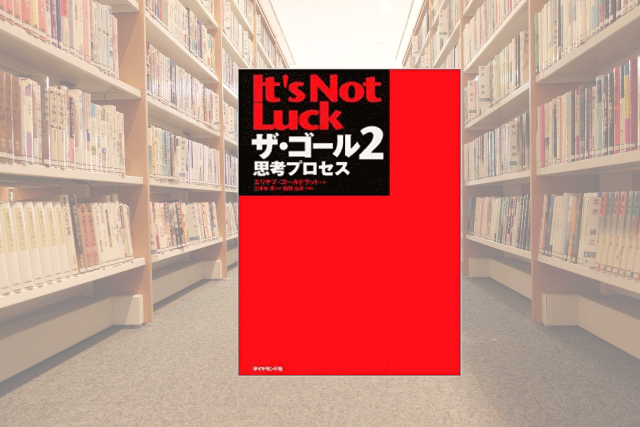
4.Dealing with non-negotiables and ingrained culture
The biggest obstacle to reforming or changing something is probably the organization’s non-negotiable commitment and ingrained culture.
You could simply call it “habits.
The reason why top management, middle managers, and even the front line may resist changing something is because of the fear of losing the “habit”.
Sometimes there is a clear background of someone’s loss of some kind of “vested interest” associated with the habit.
Somehow, I think there are many people who disagree that breaking the “habit” is not a good idea.
There are also those who say that breaking the “habit” will have “side effects” or “obstacles” and that it will not work.
I think this is the most difficult part of reform.
In my experience, opposition to breaking such “non-negotiable commitments” and “ingrained culture” is often a judgment based on strong assumptions, but it is also unwise to force these opinions.
There are two ways to deal with this.
- Convince (or persuade) the opposition
- Leave the obsession and culture behind and proceed with the reform
In order to convince the opponents, it is necessary to provide convincing explanations one by one for each of the “obstacles” and “side effects” that are the source of the opposition.
Although we are concerned about complete reform, we need to be prepared for a difficult road ahead, as it is a reform plan without compromise.
In a sense, looking for areas that can be reformed while retaining the commitment and culture means looking for a compromise.
If the reform is based on incorporating Lean development as a best practice, for example, the reform will be based on carefully learning the essence in the theory and focusing on the areas that we really want to reform while leaving some of the current issues unresolved.
In this case, by narrowing down the goals to be achieved, we would create a reform plan in a goal-specific form.
It is not a complete form of reform, but it may be easier in practice because it seeks the necessary effects with limited changes.
The duration of the reform may also be achieved in a shorter period of time compared to a complete form of reform.
I think it will be a trade-off between the effectiveness and scope of the reform and the degree of difficulty.
5.Resources available for the reform
Another very important question is how many resources, i.e., people, money, and time, are available to carry out the reform.
The answer to this may be a direct reflection of how prepared the top management is.
I believe that the degree to which the top management itself is willing to get involved has a lot to do with the success of the reform.
Reforms will never succeed if they are left to the field.
A common mistake is for the top management to feel comfortable leaving the task to the middle managers and not get directly involved.
Unless the middle manager is very good, the middle manager will not put much effort into something that the top management is not very involved in.
As a result, they end up throwing everything at the field.
Reforms are usually carried out while doing existing work.
If the top management is unclear about which has higher priority, the continuation of the existing business or the reform, and says that both are important, the middle managers will prioritize the continuation of the existing business, which can easily produce visible results and is definitely valued.
The most important thing is for the top management to be serious in order to implement the reform and make it successful.
The next most important thing is the time allowed for the reform and the allocation of human resources to accomplish it.
If you do it mentally in six months or with a small number of people, what will work will fail.
It is important to accurately estimate the time and resources required based on the correct strategy, a solid action plan, risk management, and stretching at a level that can be achieved with 120% effort and full support from management.
Considering the steps of reform on a practical level, it is usually
- Create a success story with a model project
- Build a new process for company-wide deployment of success stories
This is a two-step process.
Assign the best members possible to the model project, overcome various obstacles with the support of management, and win the company’s success story.
Since company-wide deployment is related to the organizational functions of the entire company, I think that the top management should take the lead in promoting this project at the company-wide level.
Reference article:
The Role of Middle Management in Product Development Process Innovation
How to proceed with Futureship development innovation and the time required
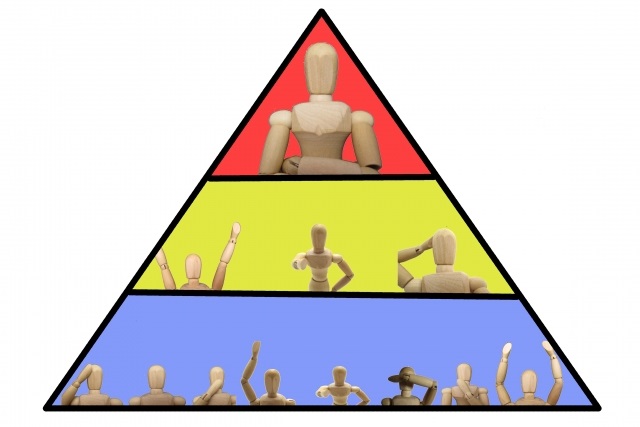
Organizational problem diagnosis service for development organizations

I have talked about how to implement organizational reform in a product development organization.
In particular, I think the key is how to put the ideal theory of Lean development methodology into practice in the field.
The first step is to understand the essence of idealism, such as Lean Development and Job Theory.
Related articles:
What is Toyota-style Lean Product Development?
Understanding Set-Based Development
Teach a framework putting Job Theory (Jobs to be done) into practice
Once you understand the essence of the theory and want to adopt it, the next thing to do is to analyze your company’s current situation.
We will discover the core issues of various organizational problems in your company and the underlying problems of multiple bad phenomenon.
We offer “Organizational Problem Diagnosis Service for Development Organizations“.
We invite you to organize your own reform team and work with us for 30 days to uncover the root issues of your organizational problems and propose strategies for reform.
Please contact us for a consultation.
